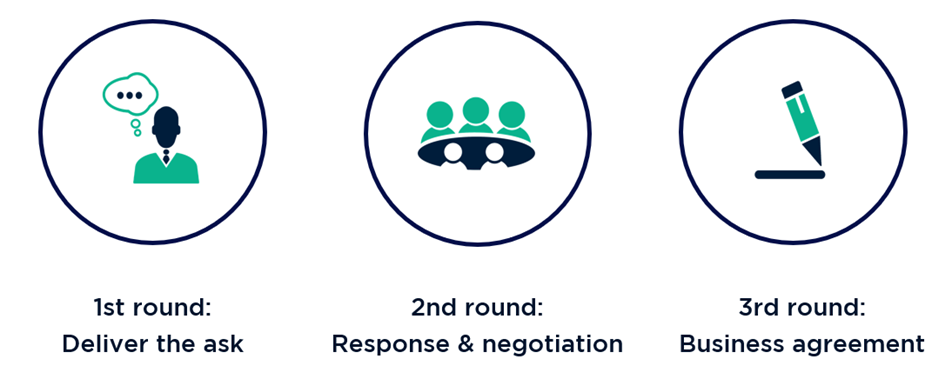
The Negotiation Powerhouse: An intensive procurement transformation that can relieve financial pressure
With disruptive innovations on the rise and upheavals taking place at an ever-increasing speed, companies can quickly – and sometimes unexpectedly – find themselves on a “burning platform”, under immense financial pressure and with existential concerns. Transformation becomes necessary, but the process is long and time is short. The challenges are particularly acute for the procurement department. Costs must be reduced even though the demand for goods and services are decreasing, and all the while staff reductions are taking place and the product portfolio is undergoing change.
But help is at hand, a solution that can provide relief in as little as three days: The Negotiation Powerhouse - an intensive price negotiation event which aims to lower costs and restructure the supplier base in the shortest time possible. It can be applied to both direct and indirect categories, and, while it is a tool often used in critical situations, can also be employed as a competition-inducing negotiation strategy in calmer seas.
The Negotiation Powerhouse is undoubtedly an effective instrument for achieving immediate and significant savings.

For compressed price negotiations, preparation is key
To successfully host such an intensive procurement transformation event requires thorough and detailed preparation underpinned with full management support. Such preparation usually takes approximately eight weeks, during which every last detail is planned out, from the selection of attending suppliers to the seating arrangements at joint meals. Clearly defined objectives, which are agreed with and legitimised by senior management, form the basis of the entire process. In addition to the objectives, the scope of the project should be clearly defined in advance and its implementation planned, including:
- Involvement and buy-in of senior management
- Volume of expenditure to be allocated
- Attending suppliers (based on results of a preliminary tender, if necessary)
- Balanced negotiation teams assigned to particular suppliers
- Empowerment of the teams to conduct price negotiations and sign agreements
- Detailed process and comprehensive schedule for the negotiation days
- “ASK” and “BID” thresholds for each individual supplier
The last weeks of preparation are used to provide intensive training to the employees involved in the price negotiations and to practise different negotiation scenarios, taking into account all eventualities and supplier responses. In the price negotiations, the teams must act as a unit in which everyone plays their clearly defined role.
Effective execution of the Negotiation Powerhouse
At the beginning of the event, it is essential to communicate to the suppliers the importance of the process and to stimulate their willingness to make radical changes. One of the key advantages of the Negotiation Powerhouse is that its brevity enables meaningful and impactful contributions from senior management. A “burning platform speech” delivered by the CEO or equivalent engages the suppliers in the process and puts them in the right frame of mind for the price negotiations to come.
Typically, each negotiation team has three rounds with up to three suppliers. On the first day, the ask is delivered, on the second day the suppliers response is discussed and negotiations start. If not obtained in the second round, the third day is meant to finalize the negotiations and to sign a commercial agreement. The simultaneous price negotiations create competitive dynamics among the selected suppliers. The information advantage can be leveraged and binding agreements can be obtained immediately.

These three days are undoubtedly stressful for the participants, so it is essential that the organisational team keeps a constant overview and coordinates all activities from a specially allocated "war room". Here, the organisers are available to answer any logistical questions about the event. Also, the procurement leadership team and coaches are available at all times to help negotiators develop new arguments and to provide tactic and content support so that the best decision can be made. The results of the price negotiations are analysed and evaluated in real time and savings are tracked simultaneously. Overall, the war room team is responsible for maintaining a high-level view of the current state of play.
To ensure the sustainability of the procurement transformation, after the event the company and its selected suppliers enter a 4-8 week implementation phase. In this phase, the signed price agreements are incorporated into the contracts and their implementation is enacted and monitored. The process of volume transfer from one supplier to another is also initiated and the savings achieved are measured and documented. If necessary, counter-measures can be initiated and the momentum can be used to develop joint activities such as joint sourcing or design to cost.
Immediate commercial improvements and enhanced supplier relations
Instant results can be seen at the commercial level in the form of preferred suppliers offering reduced prices, as well as a transfer of volumes from previously more expensive to lower cost suppliers. A common outcome of the negotiations is an upfront payment from suppliers as a concession for an increase in order volumes.
In addition to the commercial results, the supplier relations are also enhanced. The suppliers recognise and are engaged with the urgency of the company’s current situation, while several days of face-to-face price negotiations and associated activities gives the team a real opportunity to get to know their supply base, making the supplier relations easier to manage. In a similar vein, the success of the process will improve the image of the procurement department within the company and strengthen the negotiating skills of the people involved.
Conclusion on the Negotiation Powerhouse
The five key factors for a successful outcome of the Negotiation Powerhouse are:
- Clearly defined negotiation targets, aligned between management and lead negotiators
- Selection of key future suppliers with sufficient volume to negotiate
- Work prioritization during the preparation phase - sufficient resources and lead-time are key
- Involvement of all relevant stakeholders within the company
- Regular follow-ups with the suppliers for sustainable savings
Whether it’s part of a procurement transformation programme or a last resort of a "burning platform", in our experience at OCM, a Negotiation Powerhouse helps set the course for a successful future. We would be happy to explain the topic in detail and discuss how we can help with the implementation of your Negotiation Powerhouse.
OCM offers comprehensive support in the design and implementation of your Negotiation Powerhouse. We combine our proven approach to strategic procurement and procurement transformation with our knowledge and experience in expediated project delivery to help you with your intensive price negotiations and enhancement of supplier relations. We would be happy to present our approach and modules in this regard or discuss concrete solution approaches based on your individual challenges.

Logistics optimisation & Supply Chain Consulting modules
Logistics & SCM Opportunity Assessment
- Benchmarking & maturity testing
- Identification of opportunities & action plan
Transport Partner Management
- Transport partner strategy & professionalisation
- Securing resources and resource training design
Transport Tender
- Competition, effective transport tendering, fact-based negotiation
- Transport cost reduction
Freight & Logistics Tender
- Competitive pricing, quality, and performance assurance
- Individual weight-distance matrix
Warehouse Optimisation
- Efficient warehouse logistics & layout
- Optimised processes & working capital
Logistics Cooperation
- Optimising logistics through synergies
- Finding a fair and stable collaboration model
Route Optimisation
- Distance and route reduction
- Reduce resource & logistics costs
Supply Chain Network Optimisation
- Optimise delivery times, service levels, & processes
- Reduce working capital
Inventory & Order Management
- Optimal order quantity & stock on hand
- Optimise working capital
Fleet Optimisation
- Fleet concept tailored to requirements
- Cost optimisation
Supply Chain & Logistics Strategy
- Sustainable maximum value contribution of the supply chain
- Clear objectives, concrete measures
Digital Logistics Management & Reporting
- Information advantages in speed, scope, & significance
- Efficiency through automation, data integration & process simplification
Interim Supply Chain & Logistics Manager
- Rapid response: candidates within 48h
- Matching of requirements and assessment of suitability using logistics experts
- From dispatcher to logistics manager
Short-term staff shortage? Unexpected need for action?
Learn more